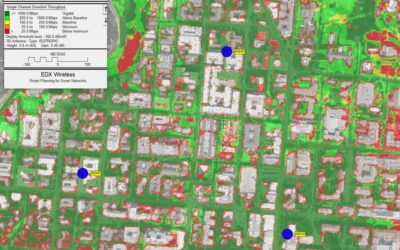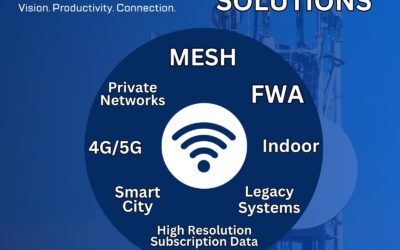The demand for greater coverage in underserved areas, the need for greater network security and reliability plus the capability of 5G and CBRS is driving the proliferation of Private Networks.
Between the applications of licensed, unlicensed, and shared spectrum applications along with services provided by hyperscalers, there is opportunity for small, mid and large-sized enterprises alike.
With the ever increasing demand for Private Networks, one of the ways in which we can best enable their successful deployments is encouraging partnerships between enterprise, operators, vendors, and all the stakeholders of these networks. We can begin by identifying the challenges and discussing the use cases of these networks in order to learn best practices and discover where we go from here.
Benefits of Private Networks
- Provide service where WiFi is not readily available
- Improved network security
- Greater bandwidth capability
- Reliability for critical applications
Private Networks today
The increased demand for Private Networks seems to have largely come at the convergence of several factors. There is obviously a greater need for coverage, reliability, and improved security. Additionally, the pandemic shined a light on a lot of the shortcomings of legacy and current networks: The need for distance learning and coverage across campuses and multiple buildings in the education sector, for example.
Another factor driving all of this is the availability of CBRS and 5G; the new technology available providing high-speed broadband, low latency and reliability to cover not only underserved areas where WiFi is not readily available, but meeting the requirements of enterprises that rely on uninterrupted and low latency networks.
Enterprise considerations:
A clearly defined use case detailing the enterprise’s requirements, expectations and service area now and in the future is essential. Private Networks require a holistic design approach to ensure these networks not only meet the requirements of today, but are scalable for expansion in the future.
In defining our use case, we will need to consider the equipment that will be needed, where the equipment will be located, how much of our service area is in-building or campus level or will need outdoor-to-indoor coverage, among other things. This holistic design approach also means bringing in system integrators, mobile operators, vendors and all stakeholders to help answer these questions.
Another question to be considered for enterprises is who will be managing your network. There are many obvious benefits to having full control over your own network, but this also represents another investment as you have to have the resources and expertise to do so. To address this need, companies such as Cisco and Ericsson are providing cloud-based management solutions that take a lot of the complexity out of system management. Moving forward, it’s probably safe to say these types of solutions will become more commonplace.
Questions for enterprise to consider:
- What is your use case?
- Who will be connecting: a set list of users and/or people who visit your facility?
- What are your security requirements?
- What type of traffic will you be accommodating: voice calls/data or machine-to-machine communication, for example?
- What is your current infrastructure and will new equipment integrate with it?
- What impact will latency have on your use case? What are the latency requirements?
- Who will be managing the network?
Private Networks on licensed, unlicensed, and shared spectrum – advantages and disadvantages
One of the main and most foundational benefits of Private Networks is to provide coverage in underserved areas and markets, areas in which WiFi is not readily available, for example. In this regard, one of the main advantages of unlicensed and shared spectrum is simply opening up opportunities for smaller and mid-sized enterprises who might not be able to take advantage of a Private Network otherwise.
Licensed spectrum can provide some advantages from a performance perspective: greater capacity and reliability due to less chance of interference for example, but they also come with regulatory challenges, and the availability of spectrum may be limited. The time and cost to overcome these challenges and the licensing costs to gain spectrum can be a large hurdle for smaller enterprises. The unlicensed applications reduce those costs and shorten the time to deployment.
New revenue models
As with so many new technology rollouts, one of the biggest challenges is determining the new revenue models or determining how much money will be saved for an enterprise and the ROI that will come with a new network deployment.
5G and CBRS offer so much exciting potential, but you’re still faced with the prospect of adapting a new network and all the cost such rollouts incur, and/or the operating costs of the network depending on the model you go with, so there’s a lot of determining how to offset those costs and making the investment worthwhile.
One thing that will likely help in determining new revenue models is the continuing of partnerships among everyone involved. These partnerships will help define and prove out new revenue models that will help enable the implementation of networks industrywide. It will be specifically beneficial for early adapters to continue to publish use cases and whitepapers describing the challenges they overcame and the end results that were achieved.
Business challenges when considering Private Networks
- New revenue streams and/or finding a proven ROI
- Who will be managing the network? Do you have the internal resources to do so yourself?
- Is the network CAPEX or OPEX?
- What are the security requirements? Will everything need to be on premises?
Enterprise’s role in setting standards
Enterprise has an important voice when it comes to the setting of industry standards. With the partnerships across the industry that see enterprise, operators, and vendors working closely together, there is a vested interest in ensuring there are network standards and those standards are met. And even with so many different unique use cases, there is an underlying commonality that lends itself to all the players having a voice in setting standards and ensuring requirements are met.
The standards of today and in the future could conceivably be considered even more important than standards of previous wireless generations as we have moved past addressing voice and data exclusively and into the realm of machine-to-machine connections, Internet of Things and applications that are dependent on low latency. Organizations such as OnGo Alliance and 5G-ACIA are critical in this regard in bringing all the many stakeholders to the table and ensuring that we are fulfilling all the next generation of wireless has to offer.
Mobile Operators and Hyperscalers
Dealing with the inherent challenges of this spectrum and mmWave frequencies is not a small task. It takes a lot of intricate planning, especially at these high frequencies where even the smallest obstruction can seriously degrade a signal. Additionally, the security of these networks is also very critical, which poses another challenge when considering the complexity of these networks. Therefore, when dealing with Private Networks, the expertise of mobile operators can be imperative. Operators can also help us ensure our networks stay up to date with the newest and latest technology releases.
Hyperscalers seem to be providing new opportunities for small and mid-sized enterprise by offering consumption-based pricing models that allow users to operate these networks with OPEX rather than CAPEX. With networks with less capital-intensive deployments, they seem to be removing the barrier to entry for a lot of enterprises.
Also, these hyperscalers seem to be big players in edge networking, and their partnerships with operators are vital. These edge applications are becoming more important with the need for greater security and users wishing to keep storage and application on prem. Furthermore, these edge networks will help performance, particularly when we start moving into things such as augmented and virtual reality.
The role of Open RAN for Private Networks
Open RAN entering into private networks can provide a lot of benefits and new innovations. If you become a vendor-neutral entity, you then have the ability to choose and mix for each component in the system. And this mix and match of vendors cooperating in the private network means we’re allowing for innovations and new methodologies. Plus with this model we should be able to more easily adapt for changes in standards and technologies and streamline changes for new use cases.
Open RAN entering the private network industry allows:
- New players enter the market: becoming a vendor-neutral entity (a big change in the industry). this gives you the ability to choose the best from the mix for each component in the O-RAN system
- Innovation: With the mismatch of vendors co-operating in the private network arenas, you are allowing for innovation and new methodologies of running a network
- Adapting to change; as we see changes in the standards for technologies, having an O-RAN platform would allow for easier adaptations to cater for new use cases and deployments
- Cost benefits of allowing new players to enter the market and not held to the legacy vendor giants
- Simplified ecosystem
Evolving the ecosystem with O-RAN to virtualize the network means:
- Enterprise can scale their mobile networks
- Cost efficiency
- Introduction of intelligence to the network (AI)
- Full visibility of network insights
- Seamless interoperability with MNOs, infrastructure can be shared
Choosing one RAN vendor
It can still be beneficial to have an Open RAN deployment even in scenarios where the enterprise picks one RAN vendor. Having an Open RAN infrastructure would allow easy scalability for future growth. You’d also be able to virtualize BBU’s to allocate resources intelligently with changing traffic demographics; other use cases such as IOT monitoring becomes a seamless task.
Automation is another factor. Having an Open-Ran architecture allows for AI and various automation within the system. This will not only help enterprises to optimize their networks but also takes out all the other various solutions you would need to monitor and optimize the network otherwise.
Furthermore, having at least one vendor would open the ecosystem and allow others to enter when the time comes.
Learning from Private Network deployments
The front end planning and dimensioning of any wireless network is vital to ensure they meet performance and budgetary requirements. This planning becomes even more important when dealing with the frequency bands of CBRS and 5G as they are quite susceptible to degradation from so many factors in the service area.
The proper planning of these networks shortens the time to deployment and reduces back end truck rolls and other issues so the network is not over or under built and we have redundancy and no single points of failure.
Data is an often overlooked but key component to network planning. High-quality land use data is needed to build an accurate model of the service area to account for land use, foliage, buildings, obstructions to ensure equipment is properly placed and all KPIs are met.
The good news is in the last few years there’s been a shift when it comes to data availability: today there’s very high resolution data available that depicts clutter heights and buildings at much lower costs than used to be.
Succinctly, putting in the investment and time on the front end will save us a lot on the back end.
Moving forward, partnerships will continue to be critical as we deploy more networks, discover new use cases, and take advantage of all Private Networks, 5G and CBRS have to offer.








